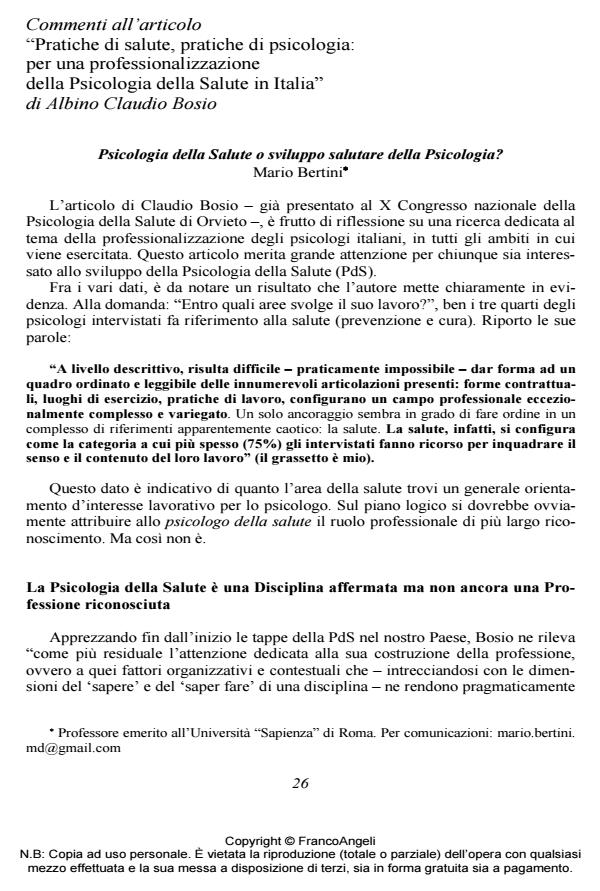Family of rules and family of affects. Which are the consequences on the well-being of adolescent offsprings?
Journal title PSICOLOGIA DELLA SALUTE
Author/s Mario Bertini, Maria Francesca Freda, Mario Fulcheri, Danilo Carrozzino, Enrico Molinari, Enrico Solano
Publishing Year 2014 Issue 2014/2
Language Italian Pages 30 P. 26-55 File size 185 KB
DOI 10.3280/PDS2014-002003
DOI is like a bar code for intellectual property: to have more infomation
click here
Below, you can see the article first page
If you want to buy this article in PDF format, you can do it, following the instructions to buy download credits

FrancoAngeli is member of Publishers International Linking Association, Inc (PILA), a not-for-profit association which run the CrossRef service enabling links to and from online scholarly content.
An effective family education implies that parents grow their own children through attitudes and behaviors related to both affective (warmth, support, etc.) and ethical-legal and regulatory (compliance, legitimacy, etc.) aspects. Literature, however, points out the current discrepancy between the affective and ethical-legal aspects - these latter are underestimated (Pietropolli Charmet, 2012; Scabini & Cigoli, 2000). The present work aims to: a) investigate if Ethical-legal and Affective Pole perceived by adolescents can affect their development and b) analyze the relationship between types of parent-child relationship and indicators of well-being and distress. A self-report questionnaire assessing the Ethical-legal and Affective Pole and some variables of well-being and distress such as depression, self-esteem, optimism, life satisfaction, and irritability was administered to 279 adolescents in northern Italy (Range 15-19 years, 46.9% male). Four types of parent-child relationships based on the combinations between the adolescents’ perception of ethical-legal and affective poles were created (high in both, low in both, high ethical-legal and low affective and vice versa). The ANOVA and post-hoc analyses show that all well-being indicators (self-esteem, optimism, life satisfaction) are more prevalent in those families in which adolescents’ perceptions present high levels of both indicators, while distress variables (irritability and depression) are less present. In contrast, families in which adolescents’ perceptions are low on both affective and ethical-legal indicators are those in which adolescents show greater difficulties: they have lower levels of selfesteem, optimism, life satisfaction, and they report more problems with depression and irritability. Families in which adolescents’ perceptions show only one of the two indicator as important produce effects that are placed in an intermediate way.
Keywords: Family relationships’ perception, adolescents, depression, optimism, irritability, life satisfaction.
- Negative Affectivity Predicts Lower Quality of Life and Metabolic Control in Type 2 Diabetes Patients: A Structural Equation Modeling Approach Chiara Conti, Giulia Di Francesco, Lara Fontanella, Danilo Carrozzino, Chiara Patierno, Ester Vitacolonna, Mario Fulcheri, in Frontiers in Psychology 831/2017
DOI: 10.3389/fpsyg.2017.00831 - The Clinical Link between Type D Personality and Diabetes Chiara Conti, Danilo Carrozzino, Chiara Patierno, Ester Vitacolonna, Mario Fulcheri, in Frontiers in Psychiatry /2016
DOI: 10.3389/fpsyt.2016.00113
Mario Bertini, Maria Francesca Freda, Mario Fulcheri, Danilo Carrozzino, Enrico Molinari, Enrico Solano, Commenti all’articolo "Pratiche di salute, pratiche di psicologia: per una professionalizzazione della Psicologia della Salute in Italia" in "PSICOLOGIA DELLA SALUTE" 2/2014, pp 26-55, DOI: 10.3280/PDS2014-002003